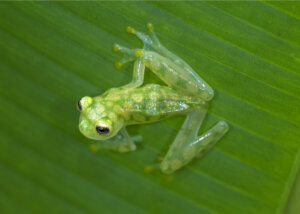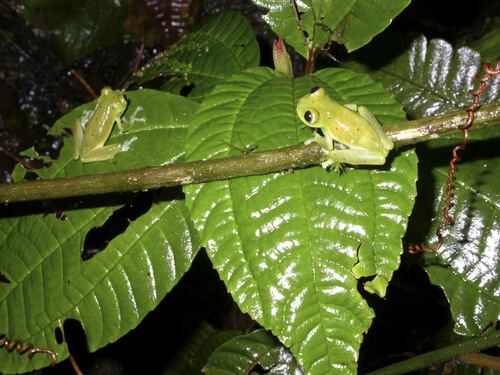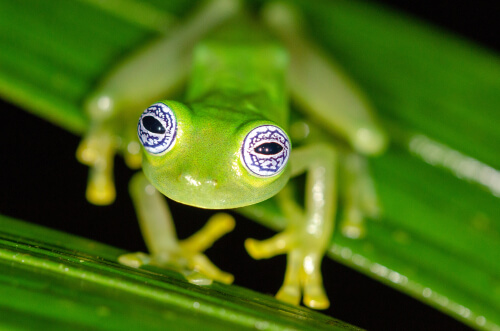Secrets of Frog Transparency


Written and verified by the psychologist Sara González Juárez
Frog transparency is one of the most fascinating forms of crypsis in nature. It could be considered the closest form of invisibility an animal could acquire to defend itself from predators.
However, how do they achieve it? Here you’ll find answers to these questions. Don’t miss anything, because it’s a more complicated process than it seems and involves certain difficulties that haven’t been fully explained. Let’s find out more.
The Centrolenidae family: the glass frogs

First of all, let’s get to know better the anurans called glass frogs, grouped in the Centrolenidae family. These amphibians, generally green in color, have translucent skin on their ventral area and are also able to gain transparency on their backs during the day.
In the Central and South American rainforests, where this frog lives, bright green abounds on the leaves of trees and shrubs, on the ground, and even on the vegetation overhanging streams. These leaves are the best refuge for glass frogs, whose nocturnal habits force them to camouflage themselves by clinging to their surface during the day.
However, researchers have always wondered how these anurans are able to increase their skin transparency. And, not only that, but one of the most difficult questions was the following: where is their circulatory system? Why can only their internal organs be seen? Well, the study we will detail below has found the key to this mystery.
Frog transparency uncovered
How the frogs merged with their environment becoming transparent has been discovered by a team of scientists who have published their findings in the journal Science. In this article, they state that this process is achieved thanks to the movement of blood to a very specific place in the body, the liver.
Part of the opacity of animal bodies is due to hemoglobin, the protein that stains hematocrit red and gives that same color to the blood. The tissues, in turn, are filled with other substances that reflect light, making them visible. Not so in glass frogs, which cast virtually no shadow when resting attached to leaves.
However, there’s a very suitable technique for studying this phenomenon, which is called photoacoustic microscopy. When skin pigments absorb light, some of it generates heat, and this changes the air pressure around them, generating waves. So, technically, you could “hear the light” with this technique.
The results of acoustic microscopy
What acoustic microscopy revealed was incredible. Part of the transparency of glass frogs is due, as they said, to the fact that the anuran moves virtually all of its blood to the liver, where it pools until the frog wakes up. They didn’t notice this until they were able to study them in captivity and during the day.
The sleeping frogs had 96.6% less hemoglobin in their blood than in their waking state.
Thus, seen from above, they camouflage almost perfectly on the leaf, but photos taken from below show a frog that appears to be carved out of glass. No veins are visible and the organs appear white, as if dried out.
Is it possible to live without blood in the body?
Clearly, this form of dynamic crypsis is fascinating and unique in nature. In fact, other transparent animals, such as krill or some species of worms, cease to be transparent out of water, and none of them modify the flow of their circulatory system.
However, more questions than answers are raised here. How does the glass frog survive a whole day without blood in its body? Why does the accumulation of blood in the liver not produce clots? The truth is that it seems like a condition that should kill the animal, but, when night falls, the glass frog takes on an almost greenish-brown hue thanks to the restoration of blood flow. And then it jumps off its leaf to forage for food.
Frog transparency and the future of hematology

The mechanisms that regulate this camouflage strategy are still hidden from human knowledge. Although we are already thinking about how to apply the future results to human hematology, what is certain is that there’s a bigger question right now. How is this family of anurans able to “get the blood out of the way” to become invisible to the eyes of their predators?
What is clear is that there’s no part of nature that doesn’t exceed the most fanciful expectations of the human imagination. In this article, we’ve found some secrets about invisibility, but what’s still to be discovered?
Frog transparency is one of the most fascinating forms of crypsis in nature. It could be considered the closest form of invisibility an animal could acquire to defend itself from predators.
However, how do they achieve it? Here you’ll find answers to these questions. Don’t miss anything, because it’s a more complicated process than it seems and involves certain difficulties that haven’t been fully explained. Let’s find out more.
The Centrolenidae family: the glass frogs

First of all, let’s get to know better the anurans called glass frogs, grouped in the Centrolenidae family. These amphibians, generally green in color, have translucent skin on their ventral area and are also able to gain transparency on their backs during the day.
In the Central and South American rainforests, where this frog lives, bright green abounds on the leaves of trees and shrubs, on the ground, and even on the vegetation overhanging streams. These leaves are the best refuge for glass frogs, whose nocturnal habits force them to camouflage themselves by clinging to their surface during the day.
However, researchers have always wondered how these anurans are able to increase their skin transparency. And, not only that, but one of the most difficult questions was the following: where is their circulatory system? Why can only their internal organs be seen? Well, the study we will detail below has found the key to this mystery.
Frog transparency uncovered
How the frogs merged with their environment becoming transparent has been discovered by a team of scientists who have published their findings in the journal Science. In this article, they state that this process is achieved thanks to the movement of blood to a very specific place in the body, the liver.
Part of the opacity of animal bodies is due to hemoglobin, the protein that stains hematocrit red and gives that same color to the blood. The tissues, in turn, are filled with other substances that reflect light, making them visible. Not so in glass frogs, which cast virtually no shadow when resting attached to leaves.
However, there’s a very suitable technique for studying this phenomenon, which is called photoacoustic microscopy. When skin pigments absorb light, some of it generates heat, and this changes the air pressure around them, generating waves. So, technically, you could “hear the light” with this technique.
The results of acoustic microscopy
What acoustic microscopy revealed was incredible. Part of the transparency of glass frogs is due, as they said, to the fact that the anuran moves virtually all of its blood to the liver, where it pools until the frog wakes up. They didn’t notice this until they were able to study them in captivity and during the day.
The sleeping frogs had 96.6% less hemoglobin in their blood than in their waking state.
Thus, seen from above, they camouflage almost perfectly on the leaf, but photos taken from below show a frog that appears to be carved out of glass. No veins are visible and the organs appear white, as if dried out.
Is it possible to live without blood in the body?
Clearly, this form of dynamic crypsis is fascinating and unique in nature. In fact, other transparent animals, such as krill or some species of worms, cease to be transparent out of water, and none of them modify the flow of their circulatory system.
However, more questions than answers are raised here. How does the glass frog survive a whole day without blood in its body? Why does the accumulation of blood in the liver not produce clots? The truth is that it seems like a condition that should kill the animal, but, when night falls, the glass frog takes on an almost greenish-brown hue thanks to the restoration of blood flow. And then it jumps off its leaf to forage for food.
Frog transparency and the future of hematology

The mechanisms that regulate this camouflage strategy are still hidden from human knowledge. Although we are already thinking about how to apply the future results to human hematology, what is certain is that there’s a bigger question right now. How is this family of anurans able to “get the blood out of the way” to become invisible to the eyes of their predators?
What is clear is that there’s no part of nature that doesn’t exceed the most fanciful expectations of the human imagination. In this article, we’ve found some secrets about invisibility, but what’s still to be discovered?
All cited sources were thoroughly reviewed by our team to ensure their quality, reliability, currency, and validity. The bibliography of this article was considered reliable and of academic or scientific accuracy.
- Taboada, C., Delia, J., Chen, M., Ma, C., Peng, X., Zhu, X., … & Johnsen, S. (2022). Glassfrogs conceal blood in their liver to maintain transparency. Science, 378(6626), 1315-1320.
- Centrolenidae (Glass Frogs, Leaf Frogs). (s. f.). Animal Diversity Web. https://animaldiversity.org/accounts/Centrolenidae/
This text is provided for informational purposes only and does not replace consultation with a professional. If in doubt, consult your specialist.








